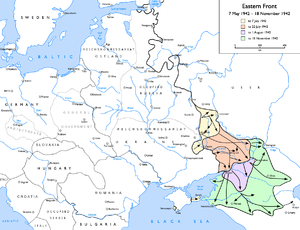| Battle of the Caucasus | |||||||
|---|---|---|---|---|---|---|---|
| Part of the Eastern Front of World War II | |||||||
 German advances in summer of 1942. | |||||||
| |||||||
| Belligerents | |||||||
|
Chechnya Georgian Rebels |
| ||||||
| |||||
| |||||
The Battle of the Caucasus is a name given to a series of Axis and Soviet operations in the Caucasus area on the Eastern Front of World War II.
Order of battle[]

c870,000 Soviet personnel were awarded this Medal "For the Defence of the Caucasus" from 1st May 1944.
Red Army[]
- North Caucasian Front (Marshal Semyon Budenny) - until September 1942
- Transcaucasian Front (General of the Army Ivan Tyulenev)
- Black Sea Fleet (Vice-Admiral Filipp Oktyabrsky)
- Azov Sea Flotilla (Counter-Admiral Sergey Gorshkov)
Wehrmacht[]
Army Group A - General Field Marshal (Generalfeldmarschall) Wilhelm List
- 1st Panzer Army- General Paul von Kleist
- 17th Army - Colonel-General (Generaloberst) Richard Ruoff
German operations[]
- August 3, 1942 - Wehrmacht takes Stavropol
- August 10, 1942 - Wehrmacht takes Maykop
- August 12, 1942 - Wehrmacht takes Krasnodar
- August 25, 1942 - Wehrmacht takes Mozdok
- September 11, 1942 - Wehrmacht takes Novorossiysk
Soviet operations[]
1941[]
There were no military operations in the region in 1941. But the region was affected by warfare elsewhere in the Soviet Union.
In his memoirs, Soviet Transcaucasian Front commander Ivan Tiulenev recounts how thousands of civilians attempted to flee from Ukraine to the comparatively safe Caspian ports, such as Makhachkala and Baku[citation needed]. The Caucasus area became a new area of industry when 226 factories were evacuated there during the 1941 industrial evacuation in Soviet Union. After the Grozny to Kiev line was captured during Axis advances, a new link between Moscow and Transcaucasia was established with the construction of the new railway line running from Baku to Orsk (via Astrakhan), bypassing the front line Grozny, while a shipping line was maintained over the Caspian Sea through the town of Krasnovodsk in Turkmenistan.
1942[]
In 1942, the German Army (Wehrmacht Heer) launched Operation Edelweiss which was aimed at advancing to the oil fields of Azerbaijan. The German offensive slowed as it entered the mountains in the southern Caucasus and did not reach all of its 1942 objectives. After the Soviet breakthroughs in the region around Stalingrad, the German forces in the Caucusus were put on the defensive.
Soviet military operations included
- Tikhoretsk-Stavropol Defensive Operation (25 July 1942 - 5 August 1942)
- Armavir-Maikop Defensive Operation (6 August 1942 - 17 August 1942)
- Novorossiysk Defensive Operation (19 August 1942 - 26 September 1942)
- Mozdok-Malgobek Defensive Operation (1 September 1942 - 28 September 1942)
- Tuapse Defensive Operation (25 September 1942 - 20 December 1942)
- Nalckik-Ordzhonikidze Defensive Operation (25 October 1942 - 12 November 1942)
1943[]
In early 1943, the Germans began to withdraw and consolidate their positions in the region due to setbacks elsewhere. They established a defensive line in the Taman Peninsula from which they hoped to eventually launch new operations in the Caucasus. The fighting remained reasonably static until September 1943 when the Germans ordered fresh withdrawals which effectively ended the period of fighting in the Caucasus.
Soviet Operations in 1943 consisted of the following.
- Salsk-Rostov Offensive Operation (1 January 1943 - 4 February 1943)
- Mozdok-Stavropol Offensive Operation (1 January 1943 - 24 January 1943)
- Novorossiysk-Maikop Offensive Operation (11 January 1943 - 4 February 1943)
- Tikhoretsk-Eisk Offensive Operation (24 January 1943 - 4 February 1943)
The key military base of Novorossiysk was retaken in September, 1943.
- January 3, 1943 - Red Army retake Mozdok
- January 21, 1943 - Red Army retake Stavropol
- January 23, 1943 - Red Army retake Armavir
- January 29, 1943 - Red Army retake Maykop
- 4 February 1943 - Soviet marines beat off a German attempt to land at Malaya Zemlya
- February 5, 1943 - Soviet forces landing in Novorossiysk
- February 12, 1943 - Red Army retake Krasnodar
- September 9, 1943 - the Germans begin to retreat from the Blue Line defensive positions
- September 16, 1943 - Red Army occupies Novorossiysk
- October 9, 1943 - Red Army controls the whole of the Taman Peninsula
1944[]
During the Winter Spring Campaign of 1944 (1 January - 31 May), the Soviet army was able to launch an invasion of the Crimea from the Caucasus. Operations included:
- Kerch-Eltingen Amphibious Offensive Operation (31 October 1943 - 11 December 1944)
- Perekop-Sevastopol Offensive Operation (8 April 1944 - 12 May 1944)
- Kerch-Sevastopol Offensive Operation (11 April 1944 - 12 May 1944)
Anti-Soviet insurgency (1940–1944)[]
- 1940-1944 Chechnyan insurgency
See also[]
References[]
| Wikimedia Commons has media related to Battle of the Caucasus. |
- Alexander Werth, The Battle of Stalingrad, Chapter 7, "Caucasus, there and back", P.648-651
- Ivan Tyulenev, "Cherez Tri Voyny" (Through Three Wars), Moscow, 1960, P.176.
The original article can be found at Battle of the Caucasus and the edit history here.